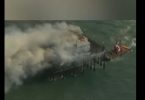Uranium mining in southern Tanzania is still under the spotlight by wildlife conservation groups worried over negative economic consequences and health risks to both the wildlife and risks to residents neighboring Tanzania’s largest wildlife park, the Selous Game Reserve.
The WWF (World Wide Fund for Nature, also known as the World Wildlife Fund in the US and Canada), Tanzania Country Office had expressed its worries over mining and extraction of uranium in the Selous Game Reserve, the largest wildlife conserved area in Africa, saying mining and industrial activities being carried on at the Mkuju River within the wildlife conserved reserve could compromise long-term economics and incur health risks to the people and the economy of Tanzania at large.
The WWF worries are in sequence of developments reported by Uranium mining company, Rosatom, which had recently signed a memorandum of understanding (MOU) with the Tanzania Atomic Energy Agency Commission (TAEC) to develop a nuclear power research reactor in Tanzania.
Rosatom, the Russian state uranium agency, is the parent company for Uranium One which has been granted a permit by the Tanzania government to mine and extract uranium at the Mkuju River within the Selous Game Reserve.
Uranium One Vice President Andre Shutov said Rosatom is going to start building a research reactor as the first stage to introduce nuclear energy development in Tanzania.
He said production of uranium will be his company’s main goal, and the first production will be made in 2018 with expectations to generate revenues for the company and Tanzania.
“We cannot make any wrong step as we expect to reach production step in two to three years’ time,” Shutov said.
He said the company had applied the latest technology on uranium extraction through In-Situ Recovery (ISR) technology being used across the world so as to avoid hazard risks to humans and living creatures.
But the WWF and nature conservationists have come up with fists, saying uranium mining in Tanzania was less beneficial in comparison to damages to be caused through the whole mining process.
The WWF Tanzania Office said uranium mining and other industrial projects proposed by multinational enterprises in the Selous Game Reserve would lead to irreparable damage, not only to the environment in terms of its ecosystem, but also to Tanzania’s precious tourism industry.
“This could be a major opportunity for the current administration in Tanzania to make a decision that will have a far-reaching legacy,” said Amani Ngusaru, Country Director of WWF Tanzania.
The Tanzania government, through the Ministry of Natural Resources and Tourism, had in 2014, set out an area covering 350 kilometers within the Selous Game Reserve in the southern Tanzania tourist circuit for extraction of uranium.
According to the memorandum of understanding, the uranium mining company will carry out significant anti-poaching initiatives ranging from game scout uniforms, equipment and vehicles, specialized training in bush craft, communications, safety, navigation, and counter-poaching tactics.
An Extractive and Energy expert with the WWF Tanzania Office, Mr. Brown Namgera, said risks of spreading leaching liquid outside of the uranium deposit involving subsequent groundwater contamination cannot be controlled.
“Contaminants that are mobile under chemically-reducing conditions, such as radium, cannot be controlled. If the chemically-reducing conditions are later disturbed for any reasons, the precipitated contaminants are re-mobilized; the restoration process takes very long periods of time, not all parameters can be lowered appropriately,” he said.
Professor Hussein Sossovele, Senior Environmental Researcher in Tanzania told eTN that uranium mining within the Selous Game Reserve could lead to dangerous consequences to the park.
Comparably, uranium mining could generate less than US$5 million per year, while tourism gains are US$6 million from tourists visiting the park each year.
“There is no significant benefit from uranium extraction in the area, taking into account that costs to build nuclear energy facilities are too expensive for Tanzania to afford,” he said.
The Mkuju River project is located within the Selous Sedimentary Basin, part of the greater Karoo Basin. Mkuju River is a uranium development project located in southern Tanzania, 470 km southwest of the Tanzanian capital city of Dar es Salaam.
The Tanzania government said the mine will produce 60 million tons of radioactive and poisonous waste during its 10-year lifespan and up 139 million tons of uranium if a projected extension of the mine is implemented.
Covering over 50,000 square kilometers, the Selous is one of the largest protected wildlife parks in the world and one of Africa’s last great wilderness areas.
The park in southern Tanzania has large numbers of elephants, black rhinos, cheetahs, giraffes, hippos, and crocodiles, and is relatively undisturbed by humans.
It is one of the largest protected areas in the world and is one of Africa’s last great wildernesses. Until recently, it has been relatively undisturbed by humans, although another plan is in process to build a hydroelectric dam on the Rufiji River which cuts across the park.
Elephant poaching has become so rampant in recent years that the park has been listed as one of the worst elephant “killing fields” in Africa by the Environmental Investigation Agency (EIA).
The Selous Game Reserve keeps the biggest wildlife concentrations on the African continent, including 70,000 elephants, over 120,000 buffaloes, more than half a million antelopes, and a couple thousand large carnivores, all roaming free in its forests, riverine thickets, steppes, and mountain ranges. Its origins date back to the German colonial times of 1896, making it Africa’s oldest protected area.








Leave a Comment